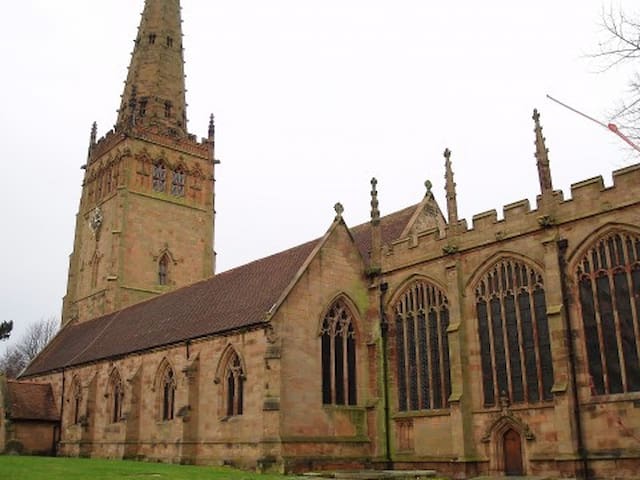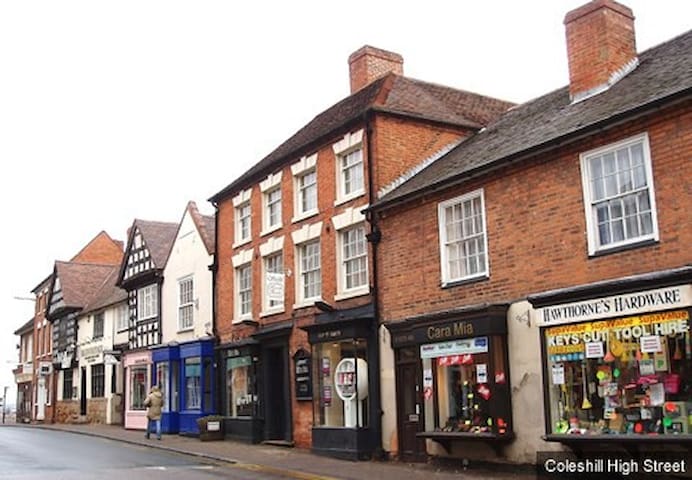Coleshill, today and historic information
Coleshill began life in the Iron Age, before the Roman Conquest of 43 AD, as the Grimstock Hill Romano-British settlement, north of the River Cole. Evidence of Hut Circles was found by archaeologists at the end of the 1970s. These excavations showed that throughout the Roman period there was a Romano-Celtic temple on Grimstock Hill. It had developed over the earlier Iron Age huts and had gone through at least three phases of development. The area was at the junction of two powerful Celtic Tribes – the Coritanii to the east from Leicester, and to the west the Cornovii from Wroxeter. In the post Roman or Arthurian period (The Dark Ages) the nucleus of Coleshill moved about a kilometre to the south – to the top of the hill. Here the present church is set and the medieval town developed around it.
By 1066 the town was a Royal Manor held by King Edward the Confessor and is recorded in the Domesday Book of 1086 as land held by William the Conqueror. Henry II granted the manor to the de Clinton family, then it passed to the de Montford’s who had moated manor houses at Coleshill and Kingshurst. King Henry VII granted the lands to Simon Digby in 1496. His descendants (Wingfield-Digby) still hold the titles. Coleshill was granted a Market Charter by King John in 1207, alongside Liverpool, Leek and Great Yarmouth. During the Coaching Trade and the Turnpike Trusts Coleshill became important as a major staging post on the coaching roads from London to Holyhead and from London to Chester to Liverpool. At one point there were over twenty inns in the town. The Coleshill to Lichfield Turnpike dates from 1743.
coleshill-church
One of the most notable buildings in the town is the Parish Church Church of St Peter and St Paul at the top of the Market Square. It has a 52 metre (170 ft) high steeple, one of the finest in Warwickshire, dating from the 13th century. Inside there is a 12th century font of Norman origin, which is one of the finest examples in the country. There are also medieval table tombs with effigies of Knights, including John de Clinton. Just outside the south door are the preserved remains of a medieval cross. The Market Square is also the location of the town’s Pillory and Whipping Post. Historically these were used to punish drunks, and bakers who sold underweight loaves. Today though, they are one of the town’s tourist attractions, having been restored and preserved by the Gascoigne family, a local family who have run businesses in Coleshill for over 100 years. At the top of Coleshill, just past Packington Lane, is a red post box that bears the Royal Seal of Edward VIII. It is one of a small number to have been placed in the UK before his abdication, of which only 14 remain.
A significant feature of the town is the Cole Bridge, which is a Grade II listed road bridge. Although originally a mid-16th Century construction to link the two portions of the town, the bridge was widened towards the west (circa 1700) and and this side has been extensively repaired in the C19 and C20.
Coleshill
Coleshill began life in the Iron Age, before the Roman Conquest of 43 AD, as the Grimstock Hill Romano-British settlement, north of the River Cole. Evidence of Hut Circles was found by archaeologists at the end of the 1970s. These excavations showed that throughout the Roman period there was a Romano-Celtic temple on Grimstock Hill. It had developed over the earlier Iron Age huts and had gone through at least three phases of development. The area was at the junction of two powerful Celtic Tribes – the Coritanii to the east from Leicester, and to the west the Cornovii from Wroxeter. In the post Roman or Arthurian period (The Dark Ages) the nucleus of Coleshill moved about a kilometre to the south – to the top of the hill. Here the present church is set and the medieval town developed around it.
By 1066 the town was a Royal Manor held by King Edward the Confessor and is recorded in the Domesday Book of 1086 as land held by William the Conqueror. Henry II granted the manor to the de Clinton family, then it passed to the de Montford’s who had moated manor houses at Coleshill and Kingshurst. King Henry VII granted the lands to Simon Digby in 1496. His descendants (Wingfield-Digby) still hold the titles. Coleshill was granted a Market Charter by King John in 1207, alongside Liverpool, Leek and Great Yarmouth. During the Coaching Trade and the Turnpike Trusts Coleshill became important as a major staging post on the coaching roads from London to Holyhead and from London to Chester to Liverpool. At one point there were over twenty inns in the town. The Coleshill to Lichfield Turnpike dates from 1743.
coleshill-church
One of the most notable buildings in the town is the Parish Church Church of St Peter and St Paul at the top of the Market Square. It has a 52 metre (170 ft) high steeple, one of the finest in Warwickshire, dating from the 13th century. Inside there is a 12th century font of Norman origin, which is one of the finest examples in the country. There are also medieval table tombs with effigies of Knights, including John de Clinton. Just outside the south door are the preserved remains of a medieval cross. The Market Square is also the location of the town’s Pillory and Whipping Post. Historically these were used to punish drunks, and bakers who sold underweight loaves. Today though, they are one of the town’s tourist attractions, having been restored and preserved by the Gascoigne family, a local family who have run businesses in Coleshill for over 100 years. At the top of Coleshill, just past Packington Lane, is a red post box that bears the Royal Seal of Edward VIII. It is one of a small number to have been placed in the UK before his abdication, of which only 14 remain.
A significant feature of the town is the Cole Bridge, which is a Grade II listed road bridge. Although originally a mid-16th Century construction to link the two portions of the town, the bridge was widened towards the west (circa 1700) and and this side has been extensively repaired in the C19 and C20.
Living in Coleshill
The market town of Coleshill sits just 11 miles east of Birmingham, close to both the M42 and M6.
Most of Coleshill is based around its long High Street passing through the centre of the town. There are a number of shops and services along the street meaning residents have only a short walk to local conveniences.
There is a strong community spirit in Coleshill, with local clubs and societies providing plenty to get involved in. Perhaps most notabley is Coleshill in Bloom, a group of residents who plant flower beds and other beautiful plantlife in the area.
There are also a number of pubs and restaurants offering a range of cuisines and evening entertainment. Award-winning Indian restaurants Rajrani and Balti Cottage offer some fantastic dishes including Birmingham’s famous balti curries. Local pubs offer a selection of British dishes, however The Red Lion in the high street also offers a Spanish inspired menu with tapas dishes and barra gallega options.
It is also home to the Coleshill Hub, helping support residents with services and advice whilst running local events including the monthly food and craft market.
Both the M6 and M42 provide Coleshill with great road links to Birmingham, Solihull, Rugby and other cities in Warwickshire and Worcestershire. Driving into Birmingham takes roughly 16 – 28 minutes at off-peak times and 20 – 55 minutes at peak times such as rush hour.
Coleshill Parkway is the closest rail station at just over 1 mile from the centre of town. From here there are direct trains to Birmingham New Street Station taking just 15 minutes on the half-hourly CrossCountry service.
Additionally, a number of bus routes call at the town including the National Express #70 that travels from Birmingham to Solihull.
Coleshill
Living in Coleshill
The market town of Coleshill sits just 11 miles east of Birmingham, close to both the M42 and M6.
Most of Coleshill is based around its long High Street passing through the centre of the town. There are a number of shops and services along the street meaning residents have only a short walk to local conveniences.
There is a strong community spirit in Coleshill, with local clubs and societies providing plenty to get involved in. Perhaps most notabley is Coleshill in Bloom, a group of residents who plant flower beds and other beautiful plantlife in the area.
There are also a number of pubs and restaurants offering a range of cuisines and evening entertainment. Award-winning Indian restaurants Rajrani and Balti Cottage offer some fantastic dishes including Birmingham’s famous balti curries. Local pubs offer a selection of British dishes, however The Red Lion in the high street also offers a Spanish inspired menu with tapas dishes and barra gallega options.
It is also home to the Coleshill Hub, helping support residents with services and advice whilst running local events including the monthly food and craft market.
Both the M6 and M42 provide Coleshill with great road links to Birmingham, Solihull, Rugby and other cities in Warwickshire and Worcestershire. Driving into Birmingham takes roughly 16 – 28 minutes at off-peak times and 20 – 55 minutes at peak times such as rush hour.
Coleshill Parkway is the closest rail station at just over 1 mile from the centre of town. From here there are direct trains to Birmingham New Street Station taking just 15 minutes on the half-hourly CrossCountry service.
Additionally, a number of bus routes call at the town including the National Express #70 that travels from Birmingham to Solihull.
Food scene
Coleshill has many places to eat and drink in the evening.
1. The Harvester at the bottom of the hill. Great food, good garden.
2. The Coleshill at the top of the high street.
3. The Swan has excellent carvery options
4. The Red Lion Tapas bar
5. The Rajrani has an award winning Balti
6. sixty fish- the best chippy in the locality.
cafes
1. cafe on the hill has gorgeous outside seating at the croft
2. Jaffas at the top of Coleshill, for delicious milkshakes
3.Le Maiz - lunchtime cafe
4. the vegan cafe.
Resorts World Birmingham is an entertainment complex in Birmingham, close to Coleshill. It has the largest casino in the United Kingdom, shopping mall, restaurants and cinemas.
The Casino is owned by Genting.
The £150 million development in Birmingham's NEC encompasses 50 shops and 18 bars, as well as restaurants, a spa, a cinema and a four star hotel.
The complex (developed by Genting) is seven stories high and spans 538,000 square feet (50,000 square meters). Its design is based on the shape of a cruise ship.
Resorts World Birmingham is the first Resorts World in Europe.
Signature attractionsCineworld IMAX Cinema
Genting Casino
Santai Medispa
Shopping Mall
VOX Conference Centre
Lindt
Genting Hotel
Resorts World Arena
Notable restaurantsAndy Waters
TGIFridays,[1]
Las Iguanas
Nandos
Robata
Gourmet Burger Kitchen
Pizza Express Bars: High Line
The World Bar
The Sky Bar
Bottega
Resorts World Birmingham
Pendigo WaySightseeing
Bear Grylls Adventure
Test your limits as you take on some of the world's most incredible mental and physical challenges inspired by Bear’s love of adventure. A new extreme day out!
Bear Grylls upplifun


